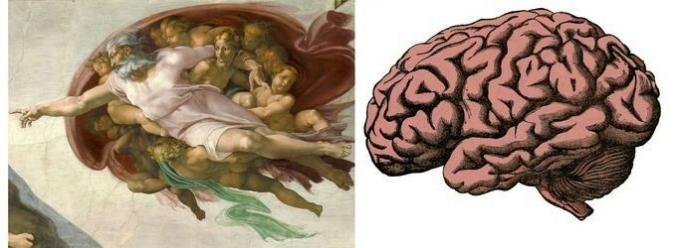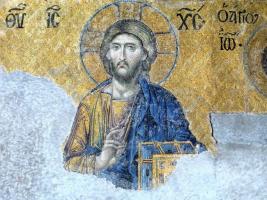Meaning of the fresco The Creation of Adam by Michelangelo
Adan creation It is one of the frescoes by Michelangelo Buonarroti that decorates the vault of the Sistine Chapel. The scene represents the origin of the first man, Adam. The fresco is part of a pictorial section of nine scenes based on the Old Testament book of Genesis.
This is one of the most representative works of the spirit of the Italian Renaissance, due to the way of representing the creation of man. They highlight the anthropomorphic image of the Creator, the hierarchy and proximity between the characters, the way in which God appears and the gesture of the hands of God and man, as original as it is revolutionary. Let's see why.
Analysis of Adan creation by Michelangelo

The scene takes place after God has created light, water, fire, earth, and other living things. God approaches man with all his creative energy, accompanied by a heavenly court.
Due to this creative energy, the scene is charged with an intense dynamism, accentuated by the undulating lines that cross the entire composition and that print a visual rhythm. Likewise, it gains a certain sculptural sense thanks to the volume work of the bodies.
Iconographic description of the Creation of Adam
The main image presents us in a single plane two sections divided by an imaginary diagonal, which facilitates establishing a hierarchy. The plane on the left represents the presence of naked Adam, who is already formed and waiting to be breathed in by the gift of life. That is why we see Adam lying languid on an earth's surface, subject to the laws of gravity.
The upper half is dominated by a group of figures suspended in the air, implying its supernatural character. The whole group is wrapped in a pink cloak that floats in the sky like a cloud. It looks like a portal between Earth and the heavenly order.
Within the group, the Creator stands out in the foreground supported by cherubs, while he surrounds a woman with his arm, perhaps Eve waiting for her turn or perhaps an allegory of knowledge. With his left hand, the Creator supports by the shoulder what looks like a child or cherub, and that some suggest could be the soul that God will breathe into the body of Adam.
Both planes seem to be joined by means of the hands, a central element of the composition: the hands open to the connection between the two characters through the extended index fingers.
Biblical sources on the creation of man

The scene represented is a very unorthodox interpretation of the painter on the book of Genesis. In this two versions of the creation of man are told. According to the first, collected in chapter 1, verses 26 to 27, the creation of man occurs as follows:
God said, "Let us make man in our image, after our likeness; and that the fish of the sea and the birds of the sky, the cattle, the beasts of the earth, and all the animals that crawl on the ground are subject to him. And God created man in his image; he created him in the image of God, he created them male and female.
In the second version, located in chapter 2, verse 7, the book of Genesis describes the scene like this:
Then the Lord God fashioned the man out of clay from the ground and breathed into his nostrils a breath of life. Thus man became a living being.
There is no allusion to hands in the biblical text. However, yes to the act of modeling clay, which is nothing more than sculpting, and sculpting is the main vocation of the artist Michelangelo. It's no wonder he's focused his attention on it. The Creator and his creature, equal in their ability to create, differ only in one thing: God is the only one who can give life.
Creation according to Genesis in the iconographic tradition

According to researcher Irene González Hernando, the iconographic tradition on creation tends to obey three types:
- the narrative series;
- the Cosmocrator (allegorical representation of God as a geometrician or mathematician with his creative tools);
- the presentation of Adam and Eve in paradise.
In those who opt for the narrative series of Genesis, the sixth day of creation (corresponding to the creation of man) receives particular attention from artists, as in Michelangelo. González Hernando says that, out of habit:
The creator, generally under the guise of the Syriac Christ, blesses his creation, which unfolds in successive phases.
Later, the researcher adds:
So we can find God modeling man in clay (eg. Bible of San Pedro de Rodas, s. XI) or breathing life into it, which is indicated by a beam of light that goes from the creator to his creature (ex. Palermo and Monreale, s. XII) or, as in the brilliant creation of Michelangelo in the Sistine Chapel..., through the union of the index fingers of the Father and Adam.
However, the same researcher informs us that during the Middle Ages, the immediate antecedent to the Renaissance, they had greater The scenes allusive to original sin are important because of the need to emphasize the role of repentance in the redemption.
If until that moment the favorite scenes of creation used to be circumscribed to Adam and Eve in paradise, the choice Michelangelo's by a less frequent iconographic type to which he adds new meanings shows a renewing will.
The face of the Creator

This iconographic model has precedents such as Creation of man by Giotto, a work dated around 1303 and integrated into the set of frescoes that decorate the Scrovegni Chapel in Padua.
There are important differences. The first lies in the way of representing the face of the Creator. It was not too often that the face of the Father was depicted, but when it was, the face of Jesus was often used as the image of the Father.
As we can see in the previous image, Giotto has remained faithful to this convention. Michelangelo, on the other hand, takes the license to assign a face closer to the iconography of Moses and the patriarchs, as had already happened in some Renaissance works.
The hands: an original and transcendent gesture
The other difference between the Giotto example and this fresco by Michelangelo would be in the gesture and function of the hands. On Adan creation by Giotto, the hands of the Creator represent a gesture of blessing of the created work.
In Michelangelo's fresco, the right hand of God is not a traditional blessing gesture. God actively points his index finger at Adam, whose finger is barely raised as if waiting for life to dwell in it. Thus, the hands seem more like the channel through which life is inflated. The absence of light emanated in the form of a ray reinforces this idea.
Everything seems to indicate that Michelangelo has portrayed a snapshot of the right moment when God prepares to give life to the work of his “hands”.
It may interest you: Renaissance: historical context, characteristics and works.
Meaning of Adan creation by Michelangelo
We already see that Michelangelo did not obey an orthodox thought, but rather created his pictorial universe from his own plastic, philosophical and theological reflections. Now, how to interpret it?
The creative intelligence

From the believer's point of view, God is a creative intelligence. Hence, it is not surprising that one of the interpretations of Adan creation Michelangelo's focus on this aspect.
Around 1990, physician Frank Lynn Meshberger identified a parallelism between the brain and the shape of the pink cloak, which envelops the Creator's group. According to the scientist, the painter would have made a deliberate reference to the brain as an allegory of the superior intelligence that orders the universe, divine intelligence.
If Frank Lynn Meshberger was right, more than a window or portal that communicates the earthly dimensions and spiritual, the mantle would be the representation of the concept of God creator as superior intelligence that orders the nature. But, even when it seems reasonable and probable to us, only a record by Michelangelo himself - a text or working sketches - could confirm this hypothesis.
Anthropocentrism in Adan creation

Be that as it may, Michelangelo's fresco stands out as a vivid expression of Renaissance anthropocentrism. Certainly we can see a hierarchical relationship between both characters, God and Adam, due to the height that elevates the Creator over his creature.
However, this height is not vertical. It is built on an imaginary diagonal line. This allows Michelangelo to establish a true "likeness" between the Creator and his creature; he allows her to represent the relationship between the two in a clearer sense.
The image of Adam seems like a reflection that is projected on the lower plane. The hand of man does not continue the downward inclination of the diagonal traced by the arm of God, but seems to rise with discrete undulations, achieving a sensation of proximity.
The hand, a fundamental symbol of the work of the plastic artist, becomes a metaphor of the creative principle, from which the gift of life is communicated, and an oblique reflection is created in a new dimension of the work created. God has made man also a creator.
God, like the artist, appears in front of his work, but the dynamism of the cloak that surrounds him and the cherubs that surround him portan indicate that he will soon disappear from the scene so that his work lives as a faithful testimony of his transcendent presence. God is an artist and man, like his Creator, he is also.
It may interest you:
- 9 works that show the incomparable genius of Michelangelo.
- Pieta sculpture by Michelangelo: analysis and meaning
- The 25 most representative paintings of the Renaissance
References
González Hernando, Irene: Creation. Digital Magazine of Medieval Iconography, vol. II, No. 3, 2010, pp. 11-19.
Dr. Frank Lynn Meshberger: An Interpretation of Michelangelo's Creation of Adam Based on Neuroanatomy, JAMA, October 10, 1990, Vol. 264, No. 14.
Eric Bess: The Creation of Adam 'and the Inner Kingdom. Daily The Epoch Times, September 24, 2018.



